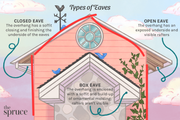Liquidoutl4w
New User
- Location
- Ny
- Occupation
- Electrician
So looking at the code on dc conduit it says must be metal when entering the interior of the structure, now when you look at that the interior wouldn't count the soffit to roof (closed eve) as it's not the interior, now how does an open eve weigh in all that. Am I wrong with my interpretation (see photo) that the red outline is considered the interior space?



